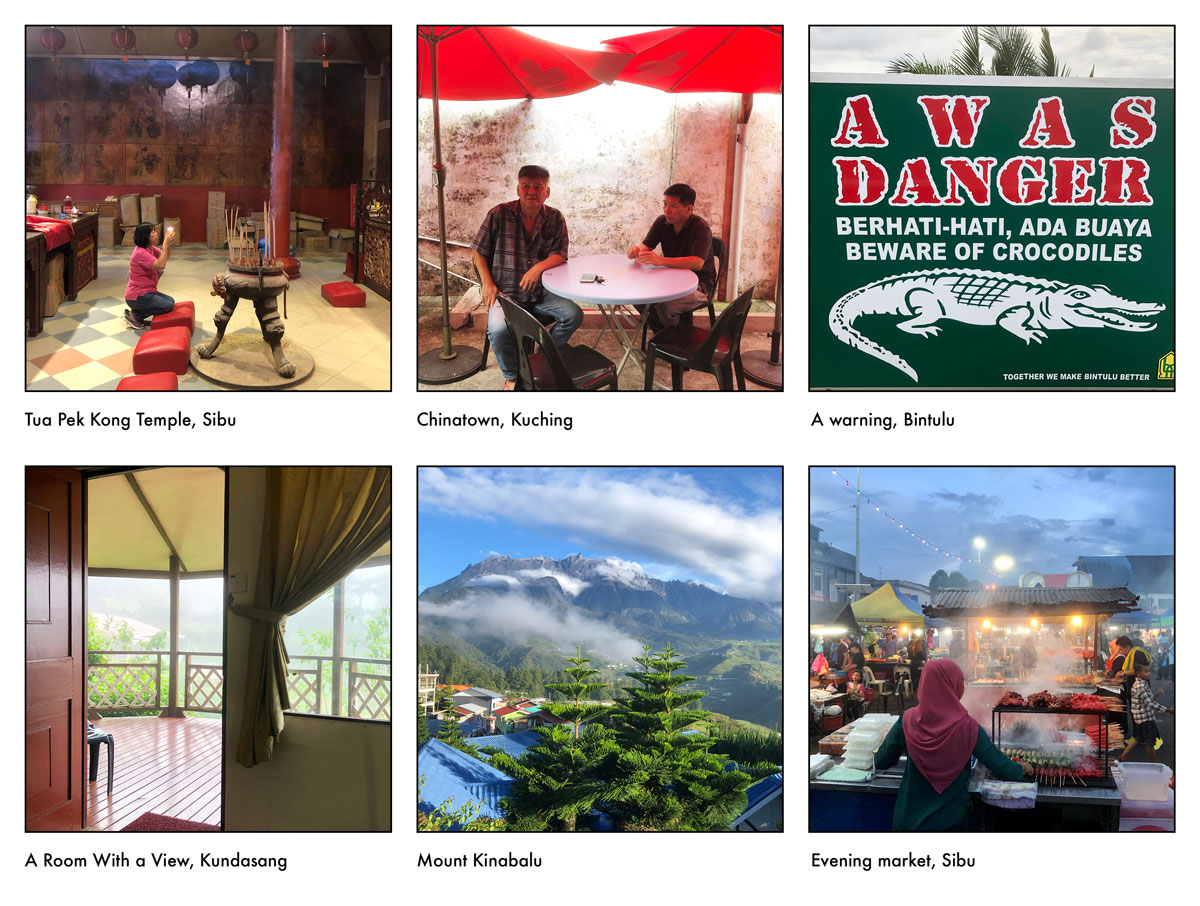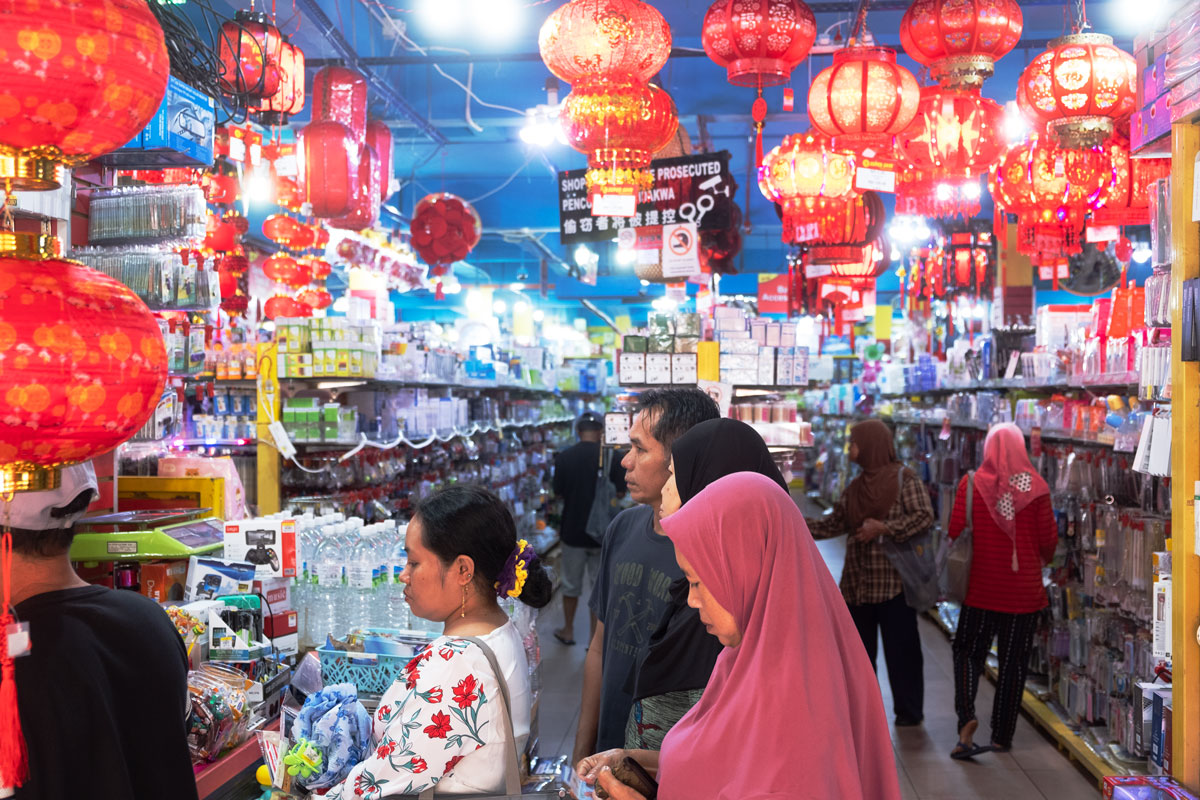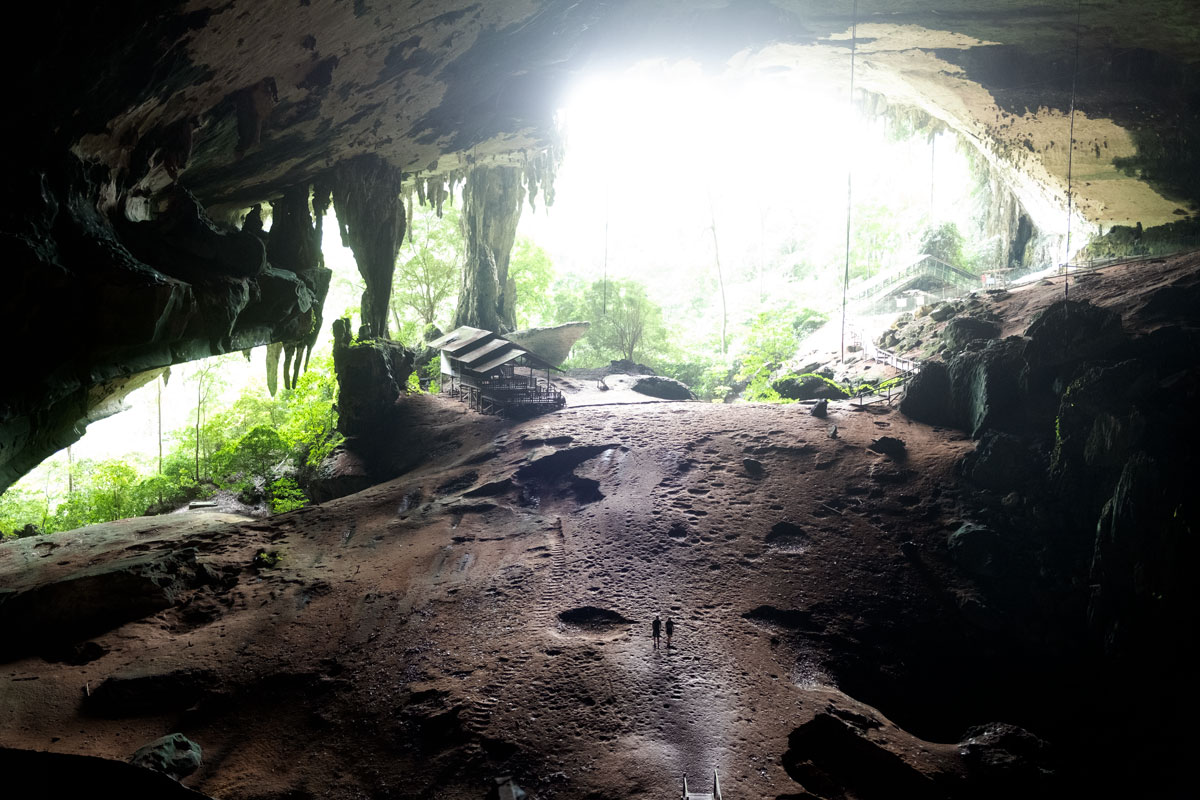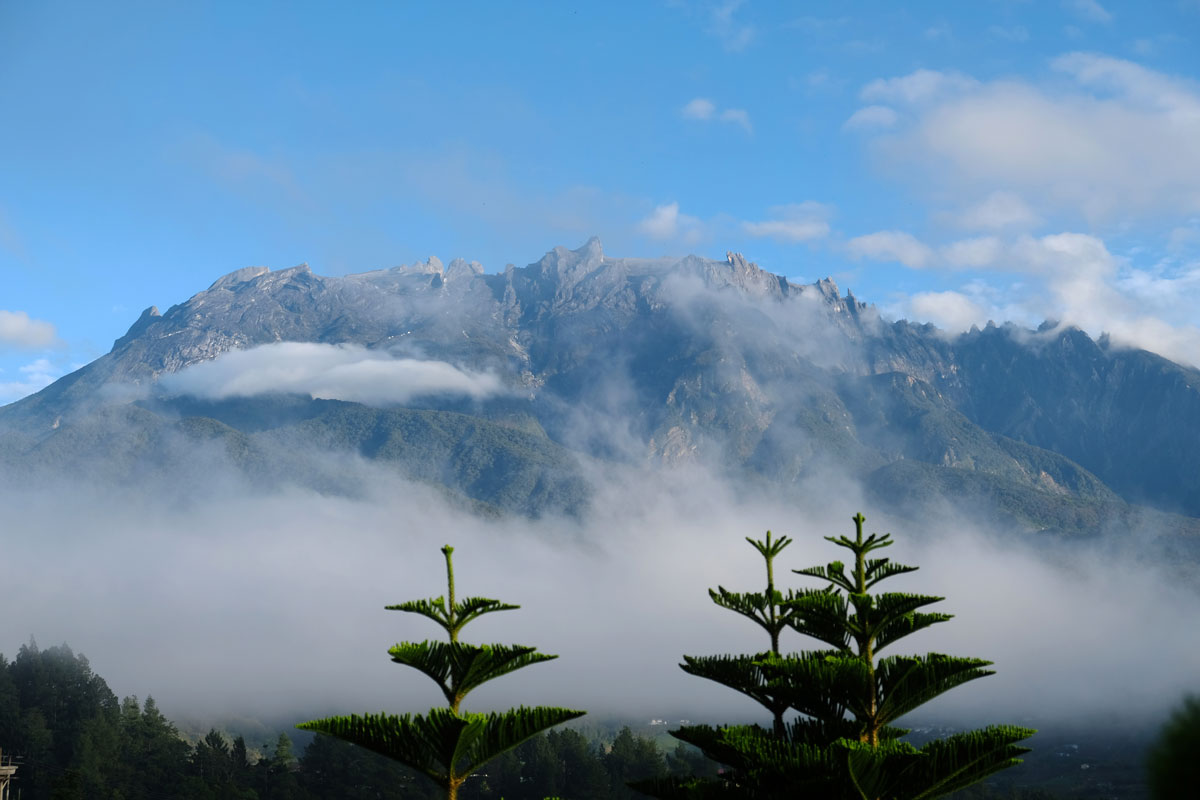Along Northern Borneo on four wheels
The final destination for our month-long journey across the northern shores of Borneo was the foothills of Mount Kinabalu. Starting out in the city of Kuching in Sarawak, we would travel more than 1000 kilometres on roads of various quality.
Even though we travelled during the wet season, not much rain kept falling on our head. During the monsoon tourism falls, even in this part of the world, and in some small towns – like the small town of Betong 265 km from Kuching – we must have been the talk of the town for months to come. Most places saw very few tourists, and of those that were, most of them were Chinese in groups. All very eager to do their selfies. Selfies must be the Chinese’s favourite pastime. Speaking of Chinese, a fairly large proportion of the population in northern Borneo are of Chinese descent. And many of them, together with the indigenous Iban population, are Christians. Even though Malaysia is a Muslim country, Islam only represents some 40 percent in Sarawak and Sabah.
We started out in Kuching, the capital of Sarawak, renting a car we were able to return in Miri, a medium sized town close to the border of Brunei. The Malaysian authorities are upgrading Highway number 1 from a standard country road to a four-lane highway. The road goes all along the coast from the border to Indonesia in the southern part of Sarawak, through Brunei and on to the state of Sabah in north-eastern Borneo, and continues into Kalimantan, which is the name of Borneo in Indonesia. The road works made the driving tough on many stretches. Don’t believe Google when calculating time between towns. It took us five hours to drive 162 km. While constructing the new road, the diverted roads were full of potholes and generally uneven surfaces. I had to keep my eyes on the road to avoid all the potholes, so I didn’t see very much of the landscape – but sorry to say, I did not miss much.
But before driving along Highway One, we spent eight nights in Kuching – also called Cat City because the name resembles the Malay word for cat. It is a laid-back city, with a pleasant walkway along the Sarawak river. As the capital of Sarawak, today a part of the Malaysian Federation, it is located on the northern shore of the third largest island in the world: Borneo.
We flew on Malaysia Airlines, a little over an hour from Singapore. We checked in to Merdaka Hotel and Palace, room 1803, 110 sqm, two bedrooms, two bathrooms (one with a tub), one extra toilet, sitting area, a small kitchenette and a big hall – all for around 270 ringgit a night. The Palace is a short walking distance to the old Chinatown, the Merdeka shopping centre and the walkway along the river. Kuching has two Chinatowns. An old one and a new one. The newest Chinatown is less touristy and more authentic. This is also where you find Chinese tea shops where the locals eat their dim sum for breakfast. The old one is largely occupied by gold smiths and pawn shops, in addition to outlets serving visitors. Chinese immigration to Sarawak came in three waves according to the Chinese Heritage Museum, which is located along the riverfront. It started in the early 19th century and most came from the coastal areas of Southern China, bringing with them their cultures and beliefs. The Chinese today make up about a third of the population of Kuching.
The state of Sarawak has an interesting history that I wasn’t aware of. For almost 100 years, until the Japanese occupation during World War II, Sarawak was governed as a private kingdom by a British family, the Brookes. It came about in 1841 when James Brooke, an English adventurer born in 1803 in British India, arrived in Kuching with his newly purchased schooner Royalist and gave assistance to the Sultan of Brunei to crush a rebellion.
In gratitude for the success, the Sultan offered Brooke the governorship of Sarawak in return for his help. Upon his death in 1868 his nephew Charles succeeded him. The white rajahs, as they were called, ruled over Sarawak functioning as an independent state until WWII arrived in Borneo. It was recognised as such by the United States of America in 1850 and the United Kingdom in 1864. According to the Brooke museum in Kuching, three generations of Brookes ruled with a love for the country and an affinity with its peoples, they resented a ruling white elite and welcomed anyone into their house. It wasn’t until 1946 that Sarawak became a British Crown colony, and in 1963 when Malaya gained its independence from the British, it became one of the 13 states that make up present-day Federation of Malaysia.
We picked up our car, a locally produced Proton Saga, at Kuching airport at around noon and arrived the small town of Betong – population 95,000 – nearly six hours later including a short break for food and toilet. The car given to us was run down and had poor acceleration. Even on a small slope it almost came to a halt. The new four-lane highway under construction all the way to the Brunei border, is expected to be completed by 2023. There are very long stretches with no villages or towns at all. Remember to fill up at every petrol station you may see, as they are few and, in case you would attempt to drive this stretch yourself. Petrol is cheap, at 2.08 ringgit a litre.
In the new part of Betong called New Township, where we stayed, I’m sure we were the talk of the town for another month. Not many foreigners to see, nor any tourists for that matter. Here is nothing to see and the only reason we’re here is we needed a place to sleep as it is too far to go to Sibu in one day from Kuching – at least when we left as late as we did.
There is no specific Chinatown in Sibu, like in Kuching. In fact, the whole town is a Chinatown as two third of the population is Chinese, mainly from Fuzhou. This follows an agreement from 1900 that allowed Chinese settlers into the area. Other ethnic groups such as Melanu, Malay, and Iban are also present, but unlike other regions of Sarawak, they are not as significant. However, Sibu is the perfect hub for visiting longhouse communities upriver. Ideally you should set aside at least three days for such a visit. One day going, one day spending, and one day going back.
The city is nicknamed Swan city, and the vibrant night market on Market Street in the centre of the town is a lively open-air night market selling mainly food, clothing and other household items. The marketplace, which is a parking lot during the day, is set up every afternoon around 5pm and operates until 10pm, sometimes later. The stalls offer all manners of household goods, footwear, fashion items, and of course food like dim sum, beef satay, BBQ chicken, BBQ pork, some cheap beer and lots more. Cakes, steamed buns, satay, pastries, dumplings and many other kinds of local delicacies are also on sale here, with shoppers happily snacking as they wander from stall to stall. The market can be reached by foot if you are staying in Sibu town. Well worth visiting is also the Sibu Heritage Centre to get acquainted with the local history. A smartly designed circular building where you turn left after the entrance and displays take chronologically through the ages and end up with the present-day situation at the exit.
The ethnic diversity of Sarawak is much more complex than in peninsular Malaysia. Sarawak has more than 40 sub-ethnic groups, each with its own distinct language, culture and lifestyle. Both the Chinese and the indigenous population constitute a larger percentage, and Islam (32 %) seems less influential as many Chinese and Iban tribes have adopted Christianity. The majority of Iban people are now Christians; but many continue to observe both Christian and traditional ceremonies, particularly during marriages or festivals. Some Ibans are devout Christians and follow the Christian faith strictly. 42 percent of the population in Sarawak are Christians.
After Sibu, next destination was Bintulu; 216 km and about 4 hours and 30 minutes away, depending on the condition of the road. Along the way we visited the Yu Lung San Tien En Si Temple Complex, also known as the Jade Dragon Temple. This sprawling new temple complex, the largest in Southeast Asia, features four main “Diana” or devotional halls. Its mission is to bring together devotees of Buddhism, Taoism and Confucianism to worship together. Its distinctive and detailed architecture make it a photographer’s paradise. Or so says the Sibu tourist brochure.
If the road between Betong and Sibu was bad, this part was even worse. We reached Bintulu just in time for a heavy downpour but was surprised by a poor selection of eating places. We ended up at the Marriot (for eating) and we were the first guests in the restaurant as the hotel had its official opening the same day. It is built on what was the runway of the first airport in the city
Bintulu remained a fishing village until 1969 when oil and gas reserves were discovered off the coast. Since then, Bintulu has become the centre of energy intensive industries. The economy has also expanded into oil palm and forest plantations, palm oil processing, wood-waste processing, and cement manufacturing. The port of Bintulu is the busiest in Sarawak. Worth visiting in Bintulu is the wet market.
On the last leg of our first part of the journey we took to the coastal road and not the Trans Borneo Highway, which turned out to be a better choice. The road was much better. We stopped in a place called Niah for a noodle soup. Niah is also the starting point for a visit to the Niah Caves. Arrived Miri town, nicknamed Seahorse City, in the early afternoon on New Year’s Eve after visiting the Taoist temple of San Ching Tian in a wealthy suburb three kilometres north of the town. We had booked into The Pullman for a bit of “luxury” for a few days, but as room wasn’t ready, we had to wait until nearly 7 pm. Miri is close to Brunei, so Bruneians come to Miri for weekends to enjoy the (relatively) liberal Malaysia. Movies are banned or more censored back home and everything is cheaper in Malaysia. That’s why the hotel was fully booked, and the staff couldn’t handle such a crowd. As a compensation we were upgraded and given a free buffet dinner.
Not a visit to Sarawak without visiting a cave. We couldn’t make it to the famous and UNESCO listed Mulu Caves, so we settled for the Niah Caves, around 100 kilometres south of Miri – the oil capital of Sarawak. After a 90 minutes’ drive and paying the ten-ringgit entrance fee it is a brisk one hour walk on a boardwalk through peat swamp forest up to the entrance of the caves. There are several caves, most of them connected, and according to Wikipedia earthenware, shell scrapers, shell ornaments, stone pounders, bone tools, and food remains were found during excavation during the latter part of the last century, and with radiocarbon dating it is established that the caves have been inhabited 40,000 years ago. Authorities are applying for UNESCO status.
Continuing to Brunei we hired a taxi at the cost of 300 ringgits for the two-and-a-half-hour-long journey. Crossing the border was a piece of cake, no questions asked, and the passport stamped accordingly.
We spent the first morning in the sultanate at the Royal Regalia Museum in Brunei’s capital Bandar Seri Begawan. Free entrance. On display was pictures of His Excellency Sultan Haji Hassanal Bolkiah Mu'izzaddin Waddaulah ibni Al-Marhum Sultan Haji Omar ‘Ali Saifuddien Sa’adul Khairi Waddien, stories about his upbringing and good character as well as gifts bestowed upon him by visiting dignitaries, both local and foreign. The grandest display is a replica of the 1968 coronation of the present sultan.
There is seldom much news from this tiny sultanate on the island of Borneo. Nothing much happens, indeed there is not much to see apart from a mosque or two, the museum and the royal palace. And some villages built on stilts in the water. However, early last year the country made international headlines as the sultan, who also is the country’s prime minister, wanted to implement the criminal component of sharia, a decision from 2014 that would mean death sentence by stoning for homosexual acts. He backed out after international outcry from George Clooney, Elton John, and others. But the laws are still on the books. Incidentally, Grindr is busy here too.
The hotel offered a small sightseeing trip for free on the second morning. First stop was the Jame’ Asr Hassanil Bolkiah Mosque, a large modern-day mosque notable for its four minarets and lavish interior and with a small garden. The mosque was inaugurated on 14 July 1994 in conjunction with His Majesty's 48th birthday celebration. No shoes, naturally, but also no mobile phones and absolutely no photography. But hijab clad women were very keen on selfies.
Before taking us back to our room, the driver took us to see the royal palace — Istana Nurul Iman, which translates as The Light of Faith Palace. The palace, which is four times the size of Versailles, can of course only be viewed from outside the gates. Not much to see, apart from the gate and the tared road leading up to whatever it is. According to Lonely Planet the palace, with a floor area of 200,000 square metres, has 1788 rooms including 257 bathrooms and a 110-car garage, an air conditioned stable for the Sultan's 200 polo ponies, and five swimming pools. In total, Istana Nurul Iman has 564 chandeliers, 51,000 light bulbs, 44 stairwells and 18 elevators.
Our room at the Brunei Hotel has one bathroom, a television, and a writing desk. But two beds. We’re doing fine.
After a few days and nights in Bandar Seri Begawan, the capital of the Brunei Sultanate, we were off to Sabah’s major city and capital; Kota Kinabalu – also known as KK. We left on BI6821 in the morning on an ATR72 aircraft. We landed ten minutes ahead of time, after having been in the air for about 25 minutes.
We had already booked at Hotel Sixty3 at 63 Jalan Gaya, that seems to be the “Chinatown” of Kota Kinabalu. The street is full of Chinese shops and was decorated for the upcoming Chinese New Year. We were approaching the year of the rat and Chinese communities around the world were preparing for the celebrations. The Chinese constitute a large proportion of the population, and streets and shops were decorated for the festival to come – much like preparation for Christmas is back home. In Chinese culture, rats are seen as a sign of wealth and surplus. Because of their reproduction rate, married couples also pray to them for children. In the terms of yin and yang, the Rat is yang and represents the beginning of a new day. We prayed for a happy new year.
The town, formerly known as Jesselton, was largely destroyed during World War II. Today the population of the city is close to half a million and is one of the fastest growing cities in Malaysia. Jesselton was the name of the vice-chairman of the British North Borneo Company that ran the state today known as Sabah. Unable to rebuild the town after the war, the company ceded the area to the British Crown Colony, and North Borneo was named Sabah as it became part of the Malaysian Federation in 1963. The oldest standing building in the town is the Atkinson Clock Tower, which was completed in 1905.
After a few days in KK, we were on the road again. Avis upgraded our order to a Proton Persona, a much better driving experience than the wreck Hertz gave us in Kuching. Good car to negotiate the climbs up to the Kinabalu Park, at the foot of the tallest mountain in Malaysia, Mount Kinabalu, standing at 4005 metres above sea level. And 20 centimetres. Climbing it, apparently, is a piece of cake, but there’s a waiting list of about one year as the authorities want to limit the number of visitors to the area, which is a UNESCO World Heritage Site.
We arrived our simple accommodation in the afternoon, Mile 36 Lodge, a nice and simple accommodation in the middle of the forest at 2000 metres above sea level, with a view to the tallest mountain in Malaysia. If we only could see the mountain, the fog was lying low, very low and so dense I could hardly see the front of the car as I was driving. It made driving on the hilly and winding roads a real challenge. Also, temperatures dropped as we climbed higher up the hills. Leaving Kota Kinabalu at 31 degrees in the morning, 18 degrees not only felt refreshing but a bit nippy. I’m glad I brought a jacket with me from home, as this excursion wasn’t planned. It was recommended by the taxi driver in Miri.
After 31 days our journey along the Northern shores of the island of Borneo had come to an end. We have travelled through the Malaysian state of Sarawak, which was once an independent country – something I didn’t know. Then on to the Brunei Darussalam, once an empire ruling over large part of Borneo and the Sulu Archipelago of the Philippines – now a tiny, oil rich sultanate with hard core Islamic rule. The last leg of our journey was to the foothills of the highest mountain in Southeast Asia, Mount Kinabalu, and we had covered a distance of more than 1,000 kilometres, most of it by driving a rented car.







